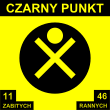Droga krajowa 4
| Droga krajowa 4 in Poland | ||||||||||||||||||||||

|
||||||||||||||||||||||
| |
||||||||||||||||||||||
| map | ||||||||||||||||||||||
| Basic data | ||||||||||||||||||||||
| Operator: |
|
|||||||||||||||||||||
| Start of the street: |
Korczowa ( 49 ° 57 ′ N , 23 ° 7 ′ E ) |
|||||||||||||||||||||
| End of street: | Korczowa ( 49 ° 57 ′ N , 23 ° 7 ′ E ) |
|||||||||||||||||||||
| Overall length: | <1 km | |||||||||||||||||||||
| Development condition: | see below | |||||||||||||||||||||
|
Course of the road
|
||||||||||||||||||||||
The National Road 4 (abbreviated DK 4 , pol. For, National Road 4 'or, national road 4') is a country road in Poland . As part of the III. Pan-European traffic corridor, part of the important traffic route from the German border to Ukraine and was accompanied on its entire route by the European route 40 . In its original route as a continuous west-east axis, it has now been completely replaced by the A4 motorway . After the completion of the A4 motorway, there is only a short section immediately before the Ukrainian border.
history
This route belonged to the Austrian Crown Land of Galicia until 1918 and was known as the Krakauer Reichsstraße . It was an important east-west link within the Habsburg Empire and linked the cities of Krakow and Lviv . Due to its great strategic importance, it was expanded into a road from 1779 under the government of Joseph II . Road construction from Silesia to the Russian border near Brody was completed within ten years . In the early years soldiers and paid workers were used to build roads, after which the residents were obliged to do slave labor. In 1893 there were 26 toll stations on the 400 km stretch between Teschen and Lemberg.
This road was declared a state road (pol .: Droga państwowa ) by the Polish Road Act of December 10, 1920 .
In 1985 the Polish road network was reorganized. The previous state roads (pol .: Drogi państwowe ) were (pol .: pl. In state roads Krajowe Drogi ; sing. Droga krajowa ) renamed and renumbered. The road from Görlitz to Lemberg (in the area of the German Reich until 1945 largely Reichsstraße 5 , west of Prochowice Reichsstraße 115 ) was designated as Droga krajowa 4 from 1986 .
Traffic safety
The road had several so-called black points (Polish: czarne dot ; singular czarny dot ). These were places where accidents occur particularly frequently. They were at Skorogosz , Brzeg , Krapkowice , Rzezawa and Targowisko. The black dots were set up in 1998. As early as 2003, no new signs were set up due to a lack of driver attention. In contrast to this, the Drogi Zaufania (German: "Trust streets") program was developed by the GDDKiA . As part of this program, various traffic safety measures were taken from 2008 onwards at places with an increased risk of accidents along the state road. For example, new intersections with traffic lights have been built to slow down traffic, new pedestrian crossings have been built and sidewalks have been added.
See also
Web links
- GDDKiA website (Polish)
- Website of the Drogi Zaufania program (Polish)
Footnotes
- ↑ M. Stöger: About Galicia's streets. In: Austrian Archive for History, Descriptions of the Earth, State Studies, Art and Literature. Born in 1832, p. 457.
- ^ Announcement of the kk Finanz-Landes-Direktion in Lemberg of September 21, 1892 Zl. 69,797, regarding the tolling of the Aerarialstraßen in Galicia. LGBl. No. 73/1892, p. 181.
- ↑ Law of December 10, 1920 on the Construction and Maintenance of Public Roads in Poland. Dz.U. 1921 no. 6 poz. 32.
- ↑ Resolution No. 192 of the Council of Ministers of December 2, 1985 on the selection of state roads. MP 1986 no. 3 poz. 16.
- ↑ Krajowej Rady Bezpieczeństwa Ruchu Drogowego, Czarne punkty ( Memento from December 30, 2013 in the Internet Archive ) (PDF file; 925 kB; Polish)
- ↑ Drogi w programie: Droga krajowa nr 4 ( Memento from June 3, 2013 in the Internet Archive ) (Polish)

